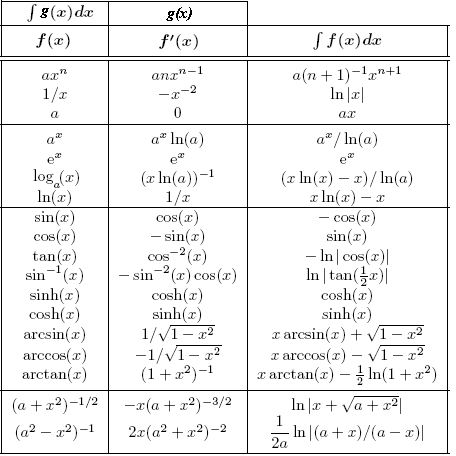|
Let f(x) be continuous on [a,b]. If G(x) is continuous on [a,b] and G´(x) = f(x) for all x ∈ (a,b), then G is called an antiderivative of f. We can construct antiderivatives by integrating. The function
PropertiesLet F(x) be any antiderivative for f(x).
∫f(x) dx is called the indefinte integral of f(x). It is used to denote: • a generic term F(x) where F is an antiderivative of f, or • the set of the terms F(x)+C (C real number) where F is an antiderivative of f, i.e. all the terms T such that È lasciata al lettore l'interpretazione della notazione a seconda del contesto (l'ambiguità di questa notazione, l'uso di un "+C" come nelle espressioni seguenti, per evidenziare che, data una primitiva, se ad essa aggiungo comunque una costante ottengo un'altra primitiva, sono brutte convenzioni entrate nell'uso in tempi antichi che, "per pigrizia", sono state mantenute; anche qui se ne fa uso, per abituare il lettore ad esercitare le opportune "interpretazioni").
Properties of the Indefinite Integral
Examples
 
Nota. La scrittura ∫(1/x)dx = log|x| (+c), spesso usata (come nella tabella riprodotta sopra), non è, a rigore, corretta: le antiderivate (rispetto a x) di 1/x non hanno la forma log|x|+c, ossia non è vero che per ogni antiderivata f(x) di 1/x esiste c tale che f(x) = log(x)+c per x>0 e f(x) = log(-x)+c per x<0, ma esistono c1 e c2 tali che f(x) = log(x)+c1 per x>0 e f(x) = log(-x)+c2 per x<0; infatti il dominio della funzione continua 1/x non è un intervallo, ma l'unione di due intervalli: esercizio e soluzione. If G(x) is continuous on [a,b] and G´(x) = f(x) for all x ∈ (a,b), then G is called an antiderivative of f. We can construct antiderivatives by integrating. The function
|
||||||||||||||||||||||||||||||||||||||||||||||||||||||||||||||||||||||||||||||||||||||||||||||||||||||||||||||||||||||||||||||||||||